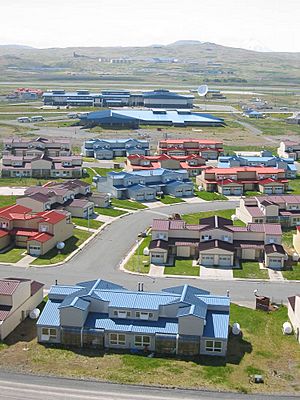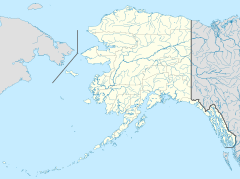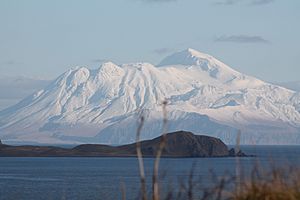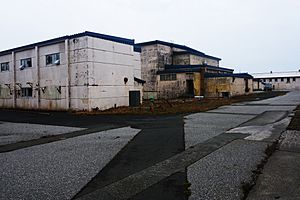Adak, Alaska facts for kids
Quick facts for kids
Adak, Alaska
|
|
|---|---|

Adak in 2006
|
|
| Country | |
| State | Alaska |
| Census Area | Aleutians West |
| Incorporated | 2001 |
| Area | |
| • Total | 71.47 sq mi (185.10 km2) |
| • Land | 32.43 sq mi (84.00 km2) |
| • Water | 39.03 sq mi (101.10 km2) |
| Elevation | 164 ft (50 m) |
| Population
(2020)
|
|
| • Total | 171 |
| • Density | 5.27/sq mi (2.04/km2) |
| Time zone | UTC−10 (Hawaii-Aleutian (HST)) |
| • Summer (DST) | UTC−9 (HDT) |
| ZIP Code |
99546
|
| Area code(s) | 907 |
| FIPS code | 02-00065 |
| GNIS feature ID | 1418109 |
| Website | adak-ak.gov |
Adak (pronounced "AY-dak") is a small city in Alaska, United States. It is located on Adak Island in the Aleutian Islands. In 2020, 171 people lived there.
Adak is special because it is the westernmost city in the United States. It is also the southernmost city in Alaska. Long ago, it was home to a big naval air facility.
Contents
Where is Adak?
Adak is on Adak Island, which is part of the Aleutian Islands. These islands are a long chain of volcanic islands. Adak is about 1,200 miles (1,930 km) southwest of Anchorage. It is also 450 miles (724 km) west of Dutch Harbor.
The city is located near the end of this island chain. It is on the same latitude as London, England. This means it is quite far north on the globe. Adak covers about 127 square miles (329 km²). Most of this area is land, but some is water.
What is the weather like?
Adak has a cool and wet climate. The skies are often cloudy. Temperatures are usually mild, but strong winds are common. It rains a lot, especially in fall and winter. December is usually the wettest month. June and July are the driest.
Winter storms can bring winds over 100 miles per hour (160 km/h). In summer, thick fog often covers the area. Temperatures usually range from 20 to 60 degrees Fahrenheit (-6 to 16 degrees Celsius). However, the wind can make it feel much colder.
Adak gets about 65 inches (165 cm) of rain each year. It also gets nearly 100 inches (254 cm) of snow in winter. But the snow usually melts quickly. Adak has about 263 rainy days a year. This is one of the highest numbers in the United States!
| Climate data for Adak, Alaska (1981–2010 normals, extremes 1942–present) | |||||||||||||
|---|---|---|---|---|---|---|---|---|---|---|---|---|---|
| Month | Jan | Feb | Mar | Apr | May | Jun | Jul | Aug | Sep | Oct | Nov | Dec | Year |
| Record high °F (°C) | 52 (11) |
54 (12) |
57 (14) |
56 (13) |
65 (18) |
67 (19) |
73 (23) |
75 (24) |
71 (22) |
62 (17) |
63 (17) |
55 (13) |
75 (24) |
| Mean maximum °F (°C) | 44.4 (6.9) |
45.2 (7.3) |
45.8 (7.7) |
48.9 (9.4) |
52.1 (11.2) |
56.8 (13.8) |
64.8 (18.2) |
67.6 (19.8) |
60.6 (15.9) |
55.0 (12.8) |
49.5 (9.7) |
46.5 (8.1) |
69.1 (20.6) |
| Mean daily maximum °F (°C) | 37.3 (2.9) |
38.0 (3.3) |
39.4 (4.1) |
42.0 (5.6) |
45.8 (7.7) |
49.8 (9.9) |
54.6 (12.6) |
57.2 (14.0) |
53.1 (11.7) |
48.5 (9.2) |
42.8 (6.0) |
38.9 (3.8) |
45.6 (7.6) |
| Daily mean °F (°C) | 32.7 (0.4) |
33.5 (0.8) |
35.0 (1.7) |
37.6 (3.1) |
41.4 (5.2) |
45.5 (7.5) |
50.0 (10.0) |
52.0 (11.1) |
48.5 (9.2) |
43.7 (6.5) |
38.1 (3.4) |
34.3 (1.3) |
41.0 (5.0) |
| Mean daily minimum °F (°C) | 28.0 (−2.2) |
29.0 (−1.7) |
30.6 (−0.8) |
33.1 (0.6) |
37.0 (2.8) |
41.2 (5.1) |
45.3 (7.4) |
46.9 (8.3) |
43.9 (6.6) |
39.0 (3.9) |
33.4 (0.8) |
29.6 (−1.3) |
36.4 (2.4) |
| Mean minimum °F (°C) | 12.9 (−10.6) |
17.4 (−8.1) |
19.9 (−6.7) |
25.8 (−3.4) |
30.8 (−0.7) |
35.8 (2.1) |
40.2 (4.6) |
40.0 (4.4) |
34.2 (1.2) |
29.8 (−1.2) |
24.9 (−3.9) |
18.1 (−7.7) |
10.6 (−11.9) |
| Record low °F (°C) | 3 (−16) |
3 (−16) |
11 (−12) |
20 (−7) |
20 (−7) |
29 (−2) |
33 (1) |
33 (1) |
28 (−2) |
22 (−6) |
12 (−11) |
8 (−13) |
3 (−16) |
| Average precipitation inches (mm) | 6.09 (155) |
4.05 (103) |
4.98 (126) |
3.14 (80) |
2.87 (73) |
2.79 (71) |
2.63 (67) |
4.22 (107) |
5.48 (139) |
6.19 (157) |
6.30 (160) |
5.96 (151) |
54.70 (1,389) |
| Average snowfall inches (cm) | 24.8 (63) |
17.3 (44) |
19.3 (49) |
7.7 (20) |
1.3 (3.3) |
0.0 (0.0) |
0.0 (0.0) |
0.0 (0.0) |
trace | 0.6 (1.5) |
10.8 (27) |
20.6 (52) |
102.4 (260) |
| Average precipitation days (≥ 0.01 inch) | 25.7 | 22.3 | 25.4 | 21.6 | 22.3 | 16.4 | 15.5 | 19.4 | 21.6 | 24.9 | 24.4 | 26.8 | 266.3 |
| Average snowy days (≥ 0.1 in) | 18.2 | 15.4 | 16.4 | 11.6 | 2.6 | 0.0 | 0.0 | 0.0 | 0.1 | 1.0 | 10.0 | 15.9 | 91.2 |
| Source 1: NOAA | |||||||||||||
| Source 2: XMACIS2 (mean maxima/minima 1981–2010) , WRCC (extremes) | |||||||||||||
History of Adak
Early History
The Aleut people (also called Unanga) lived in the Aleutian Islands for a long time. Adak Island was once very populated. But in the early 1800s, many Aleuts moved east. They followed the Russian fur trade. This caused the island to become empty for a while. However, the Aleuts still came back to hunt and fish.
Military Base
During World War II, Adak became very important. The U.S. and Canadian forces built military bases there. These bases helped them fight against Japan. After the war, Adak became a naval air station. It played a big role during the Cold War. It was a center for watching submarines.
Large earthquakes shook the island in 1957, 1964, and 1977.
At its busiest, the naval station had over 6,000 Navy and Coast Guard people. Their families also lived there. The base had many facilities for them. These included a McDonald's, a Baskin-Robbins, a movie theater, and a swimming pool. There were also bowling alleys and sports courts. A new hospital was built in 1990.
In 1994, the base started to get smaller. The McDonald's and schools closed. The naval station officially closed in 1997.
Adak Today
After the base closed, The Aleut Corporation bought the facilities. This happened in 2004. They wanted to develop Adak as a business center. In 1998, about 30 families moved to Adak. Many of them were Aleut Corporation shareholders. The old high school reopened for students from kindergarten to 12th grade.
Adak became a city in April 2001. Most of the buildings and services in Adak are owned by Aleut Corporation. They lease out properties that are in use. The U.S. Navy is now thinking about reopening the air base at Adak.
Population
Adak first appeared as a "census-designated place" in 2000. Before that, it was known as the Adak Naval Station. In 2001, it officially became a city.
The population of Adak has changed a lot over the years:
- 1970: 2,249 people
- 1980: 3,315 people
- 1990: 4,633 people
- 2000: 316 people
- 2010: 326 people
- 2020: 171 people
In 2010, Adak was the only city in Alaska where most people were of Asian background.
See also
 In Spanish: Adak (Alaska) para niños
In Spanish: Adak (Alaska) para niños




